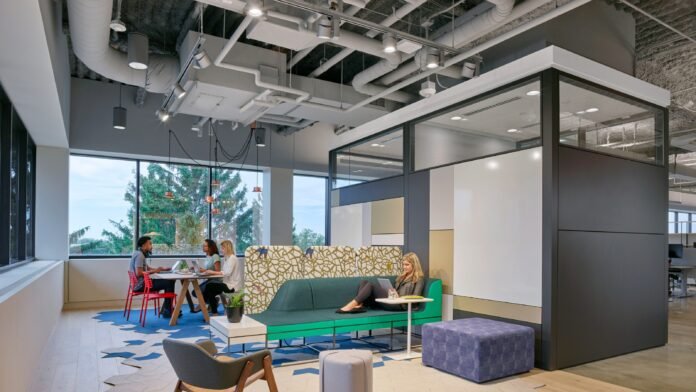Designing corporate interiors goes beyond aesthetics; it’s about creating spaces that promote employee well-being, productivity, and satisfaction. With the shift towards prioritizing employee wellness in the workplace, interior decor plays a crucial role in shaping the office environment. Here are some expert tips on how to design workplaces for employee well-being:
- Incorporate Biophilic Elements: Integrate natural elements such as plants, natural light, and organic materials into the office design to create a connection with nature. Biophilic design has been shown to reduce stress, improve mood, and enhance cognitive function among employees.
- Foster Collaboration and Interaction: Design open-plan layouts and communal spaces that encourage collaboration, teamwork, and spontaneous interactions among employees. Incorporate comfortable seating areas, breakout zones, and collaborative workstations to facilitate communication and idea-sharing.
- Prioritize Comfort and Ergonomics: Invest in ergonomic furniture and adjustable workstations to support employee comfort and reduce the risk of musculoskeletal injuries. Provide ergonomic chairs, height-adjustable desks, and supportive accessories such as footrests and monitor arms to promote proper posture and reduce strain.
- Create Flexible Workspaces: Design flexible work environments that cater to different work styles and preferences. Incorporate versatile furniture solutions such as modular seating, movable partitions, and adjustable meeting rooms that can easily adapt to changing needs and activities.
- Enhance Acoustic Comfort: Address noise and distractions in the workplace by incorporating sound-absorbing materials, acoustic panels, and noise-canceling technologies. Create designated quiet zones and private areas where employees can focus and concentrate without interruptions.
- Promote Wellness Programs: Integrate wellness programs and amenities into the office environment to support employee health and well-being. Offer amenities such as on-site gyms, meditation rooms, and healthy snack options to encourage physical activity, relaxation, and healthy lifestyle choices.
- Incorporate Personalization: Allow employees to personalize their workspace with personal belongings, photos, and decor items that reflect their personality and interests. Personalized spaces can create a sense of ownership and belonging among employees, leading to increased satisfaction and engagement.
- Emphasize Lighting Design: Optimize lighting conditions in the workplace by maximizing natural light and incorporating adjustable artificial lighting systems. Proper lighting can enhance mood, energy levels, and productivity while reducing eye strain and fatigue.
- Encourage Movement and Activity: Design office layouts that encourage movement and physical activity throughout the day. Incorporate walking paths, standing desks, and active workstations to promote a healthy and dynamic work environment. Encourage employees to take regular breaks and participate in wellness initiatives such as fitness challenges or lunchtime yoga sessions.
- Implement Biophilic Design Principles: Extend biophilic design principles beyond the incorporation of natural elements and greenery. Integrate elements such as natural textures, colors, and patterns inspired by the natural world. Consider using materials like wood, stone, and water features to create a calming and harmonious environment that enhances employee well-being.
- Support Mental Health and Stress Reduction: Design spaces that support mental health and stress reduction by incorporating features such as quiet meditation rooms, relaxation areas, and designated spaces for mindfulness activities. Create a calm and tranquil atmosphere that allows employees to recharge and decompress during stressful moments.
- Prioritize Sustainability and Environmental Responsibility: Incorporate sustainable design practices and eco-friendly materials into the workplace to reduce environmental impact and promote a healthier planet. Choose energy-efficient lighting, HVAC systems, and sustainable building materials to create a greener workspace that aligns with corporate values and goals.
- Foster a Sense of Community and Belonging: Design communal spaces that foster a sense of community and belonging among employees. Create designated areas for socializing, team building, and celebrating milestones to strengthen bonds and cultivate a positive organizational culture. Encourage cross-departmental collaboration and inclusivity to promote a sense of unity and camaraderie within the workplace.
- Seek Employee Feedback and Collaboration: Involve employees in the design process by soliciting their input, feedback, and ideas for creating a more employee-centered workspace. Conduct surveys, focus groups, or design workshops to gather insights and preferences from staff members. By involving employees in the decision-making process, you can ensure that the final design reflects their needs and preferences.

